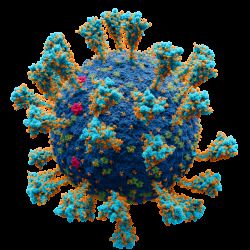Fatigue, sometimes profound, is one of the most common and debilitating features of long COVID. Its presence predicts far worse clinical outcomes, as evidenced by deaths and hospitalizations, than patients without fatigue.

By now, virtually everyone knows many people who have had COVID. Although most who get it recover within a few days or weeks, it has killed 1.2 million Americans (with the weekly death toll still in the hundreds), and even those with only mild infections can experience long COVID, marked by persistent, sometimes debilitating symptoms that last for months or even years following the acute infection.
According to Scripps Research Translational Institute’s Dr. Eric Topol and coworkers in a January 2023 article in Nature Reviews Microbiology: “At least 65 million individuals worldwide have long COVID, based on a conservative estimated incidence of 10% of infected people and more than 651 million documented COVID-19 cases worldwide; the number was likely much higher due to many undocumented cases.”
An article from the National Center for Health Statistics reported that in 2022, a shocking 6.9% of U.S. adults reported ever having experienced long COVID, defined as the presence of symptoms for at least three months after having COVID among persons who reported either a positive test or a doctor’s diagnosis of COVID. Currently, more than 5% of American adults are experiencing long COVID, which is not entirely preventable by vaccination and for which there is currently no FDA-approved treatment. They will place continuing, significant demands on our healthcare system.
The largest number of long COVID cases are in non-hospitalized patients who have experienced a mild acute illness – not because they are more susceptible, but simply because this population represents by far the most COVID-19 cases overall.
A large group of academic researchers identified symptoms that are the most diagnostic of long COVID, including fatigue, especially after exercise; brain fog; dizziness; gastrointestinal symptoms; heart palpitations; sexual dysfunction; loss of smell or taste; thirst; chronic cough; chest pain; and abnormal movements.
The prospect of long COVID bodes ill for many Americans and, going forward, for the already stressed U.S. healthcare infrastructure as well. As infections continue, albeit at a far lower rate than during past surges, so do cases of long COVID, often causing prolonged symptoms so severe that those affected are unable to work. It is thought that there are already more than a million such people in the U.S., and the number is growing.
The stark reality of severe long COVID was captured in this excerpt from a February 18 New York Times news article:
Senator Roger Marshall’s voice was shaking with emotion as he made the case for speedy and focused research into long COVID. Marshall, the junior senator from Kansas, is a Republican and a medical doctor. But addressing the first-ever Senate hearing on long COVID last month, he wanted the audience to know that his interest wasn’t just professional and it definitely wasn’t just political. It was also personal.
One of his loved ones, he explained, suffered from severe long COVID. “We’ve taken my loved one to dozens of doctors,” he said. “I’ve talked to 40, 50, 60, 80. I’ve read everything there is to read about long COVID, talked to other members of the Senate that have had long COVID. What are they doing? So I share your frustration.”
It was personal for many in the audience, as well…
Fatigue, sometimes profound, is one of the most common and debilitating features of long COVID. A recent study by researchers at the CDC and University of Washington estimated the incidence rates of post-COVID fatigue and chronic fatigue by analyzing electronic health records data of 4,589 patients with confirmed COVID and comparing them to data from 9,022 non-COVID controls. They defined an incident, or occurrence, of fatigue as a patient who had one or more diagnostic codes for fatigue during the post-acute period reported in the Electronic Health Record (EHR). Chronic fatigue was defined as having any specific chronic fatigue-related diagnoses in the EHR. The figure below summarizes their findings.
Legend: Cumulative incidence of fatigue (A) and chronic fatigue (B) among 4,589 COVID-19 cases and 9,022 non–COVID-19 controls in study of fatiguing illness after SARS-CoV-2 infection, Washington, USA, February 2020–February 2021.... Data from the CDC.
The results showed that COVID patients were 68% more likely to experience fatigue and more than four times as likely to suffer from long COVID than non-COVID controls. The rate of these diagnoses was higher among women than among men and increased with advancing age. Patients with more comorbidities experienced higher incidence rates than those without comorbidities. However, even among younger patients, those without comorbidities, and those not hospitalized for acute COVID-19, the incidence of fatigue was only slightly less. (The significant number of subjects in the non-COVID control group who experienced incidents of fatigue (Panel A) might seem surprising, but it is likely due to some “control” subjects having had undiagnosed COVID or other illnesses.)
Fatigue in COVID is a bad portent. COVID patients with fatigue, as reported in Electronic Health Records, had far worse clinical outcomes, as evidenced by deaths and hospitalizations, than patients without fatigue. Among COVID patients in whom fatigue developed, 25.6% were hospitalized more than once during the post-acute period, compared to 13.6% of patients without fatigue. Moreover, COVID patients with incident fatigue were at higher risk of dying during the post-acute period than were COVID-19 patients without incident fatigue.
The authors’ conclusions are important and should be heeded:
COVID-19 is associated with a significant increase in new fatigue diagnoses, and physicians should be aware that fatigue might occur or be newly recognized more than one year after acute COVID-19… The high incidence rates of fatigue reinforce the need for public health actions to prevent infections, to provide clinical care to those in need, and to find effective treatments for post–acute COVID-19 fatigue.
